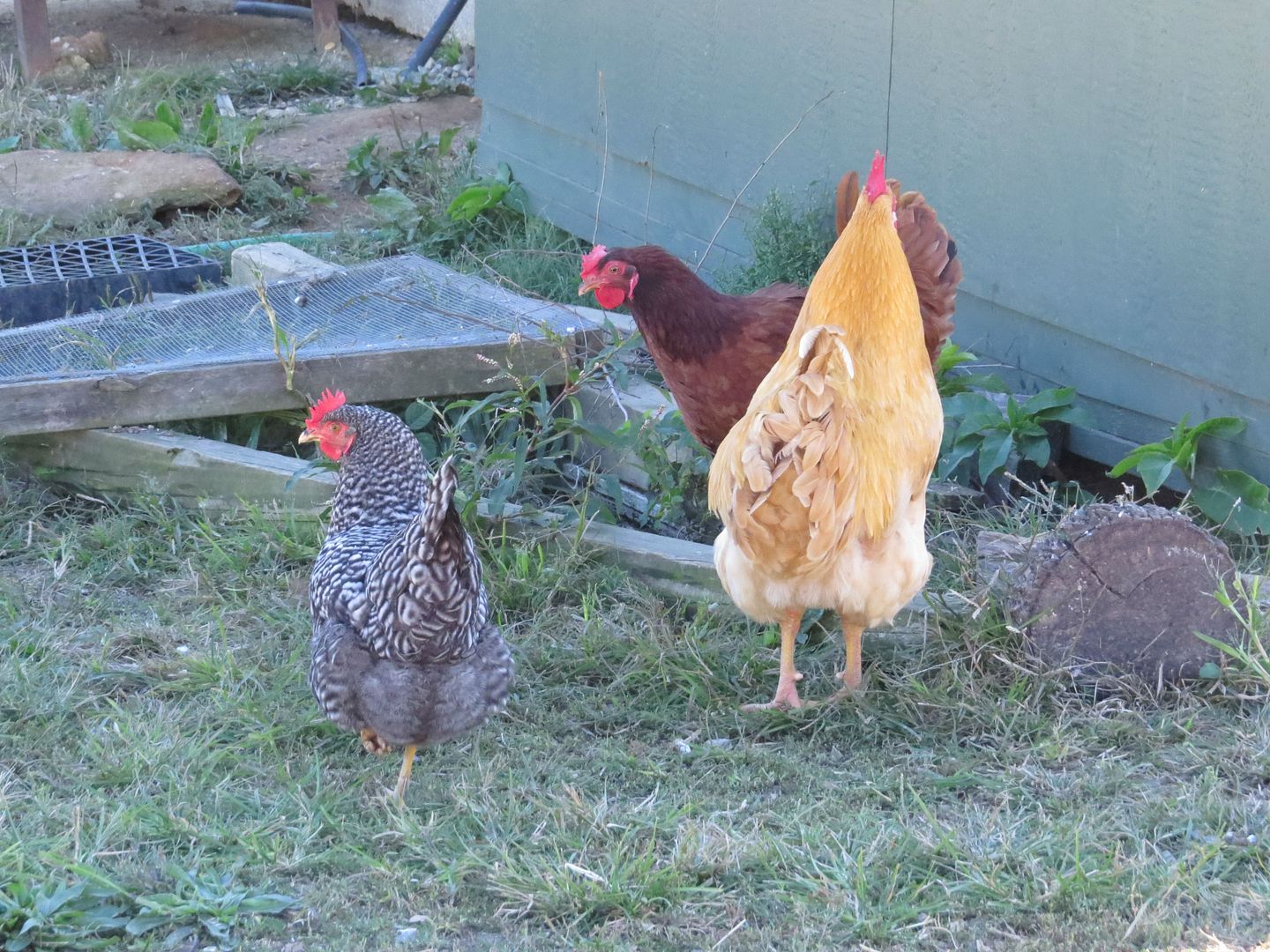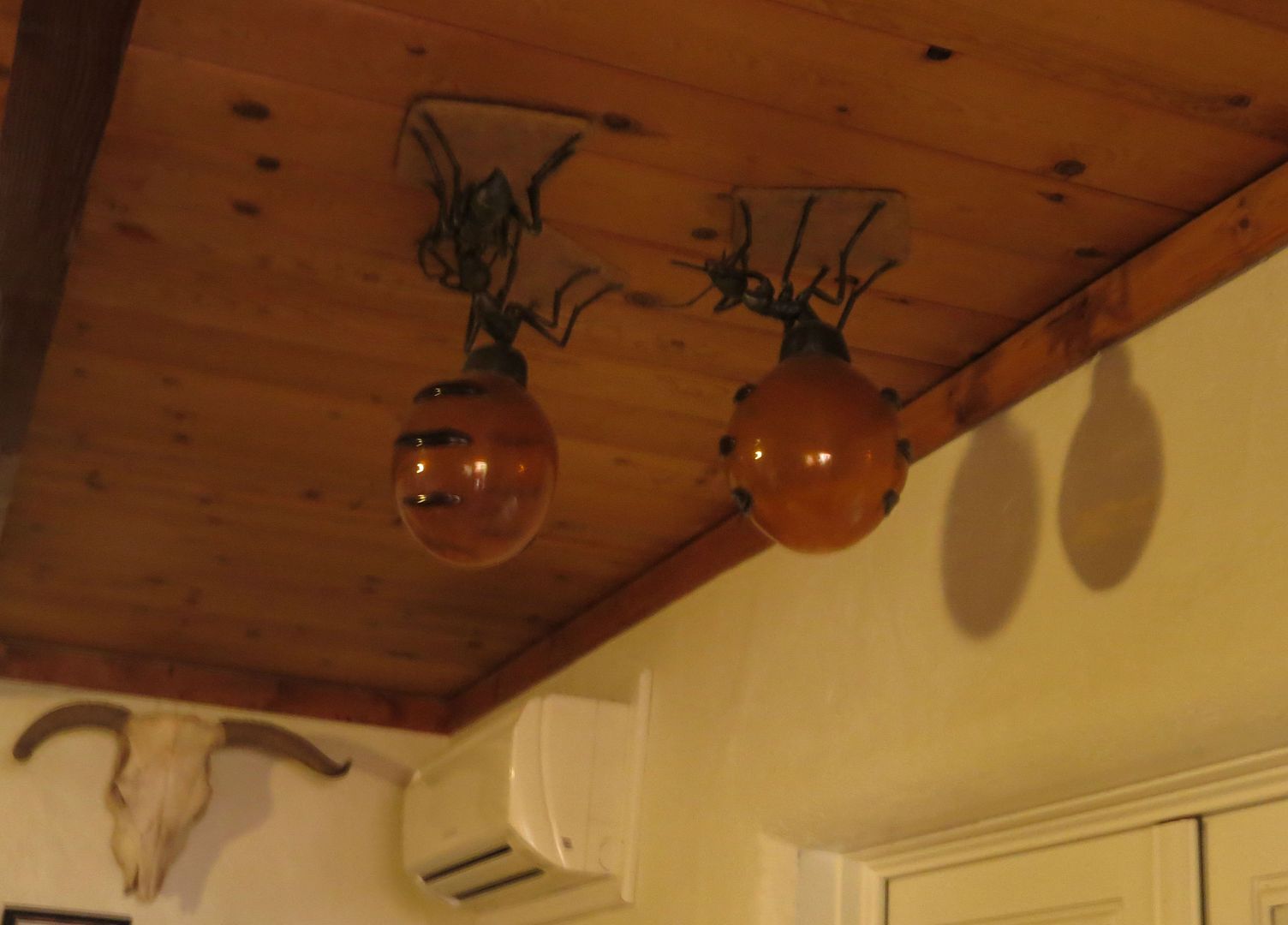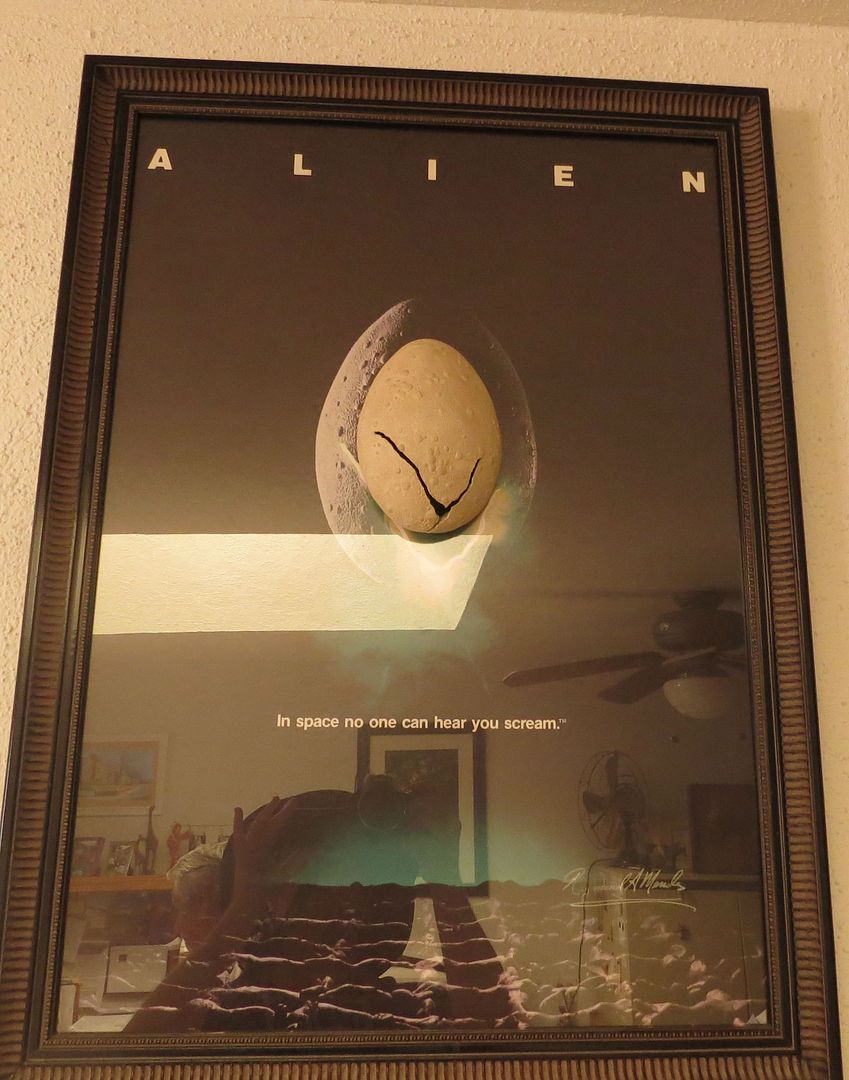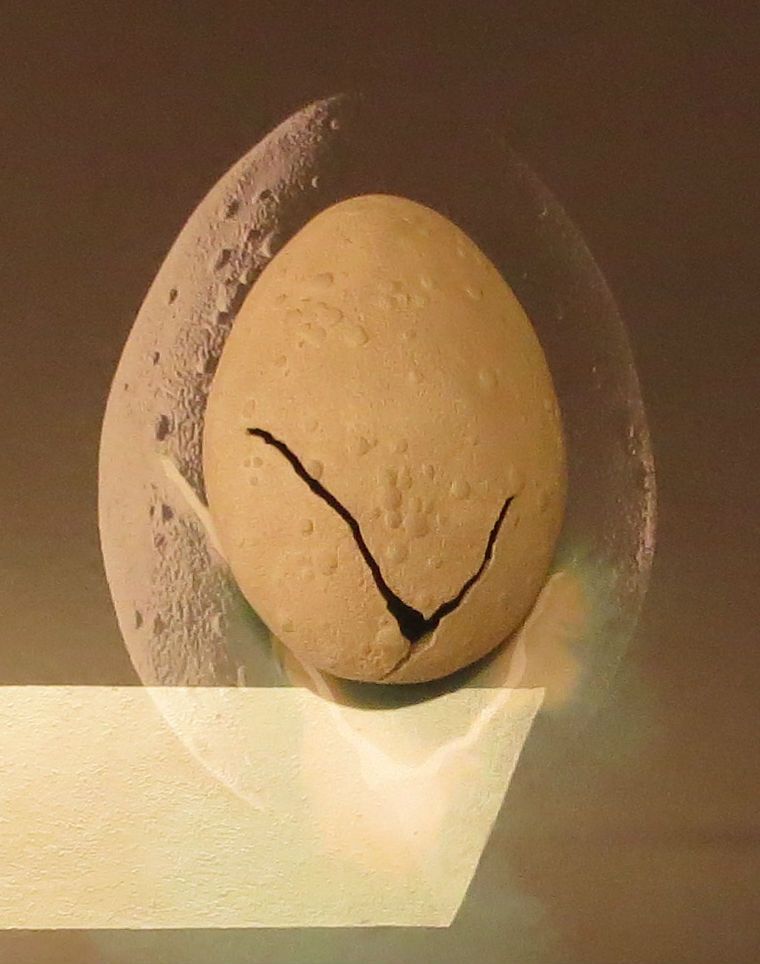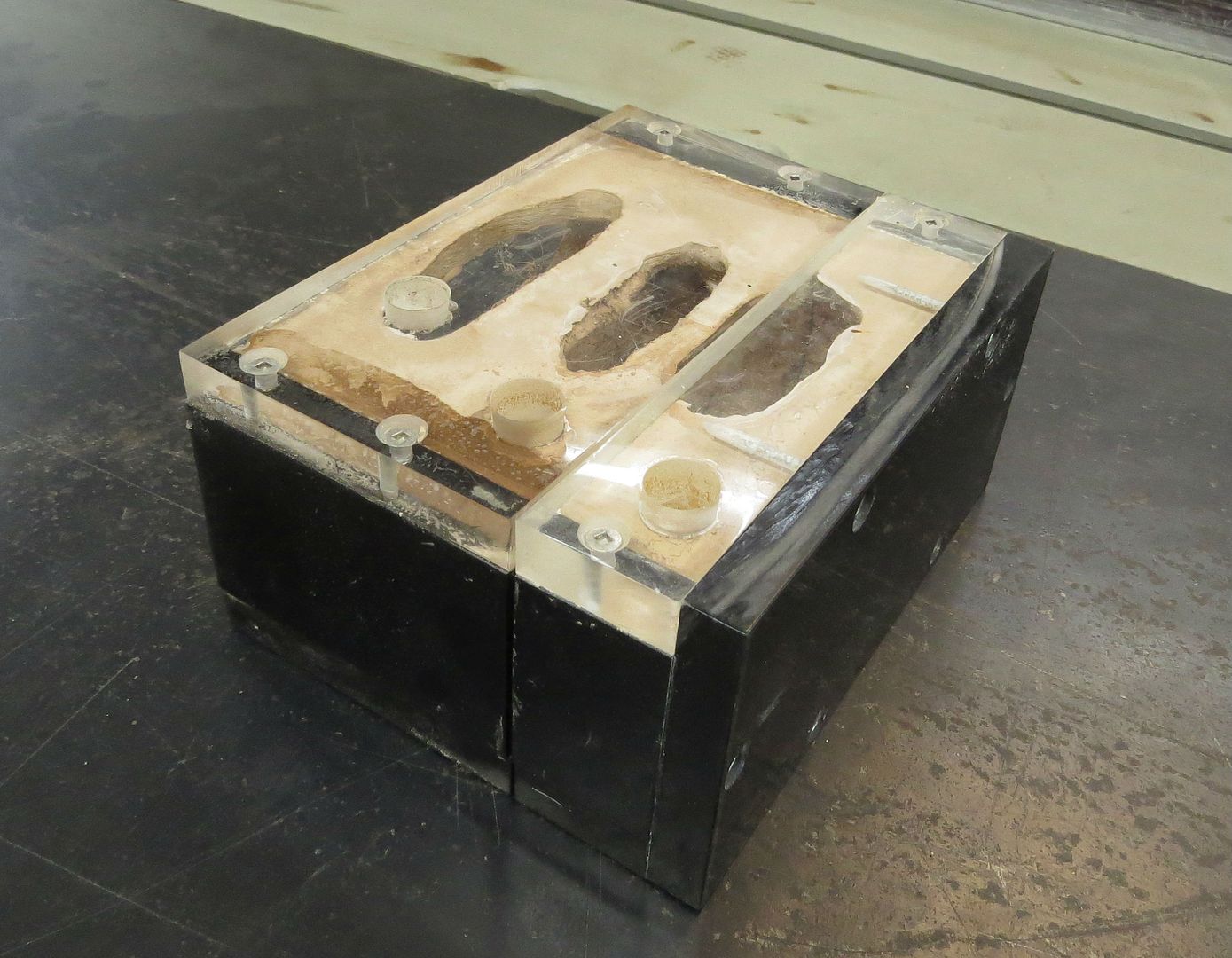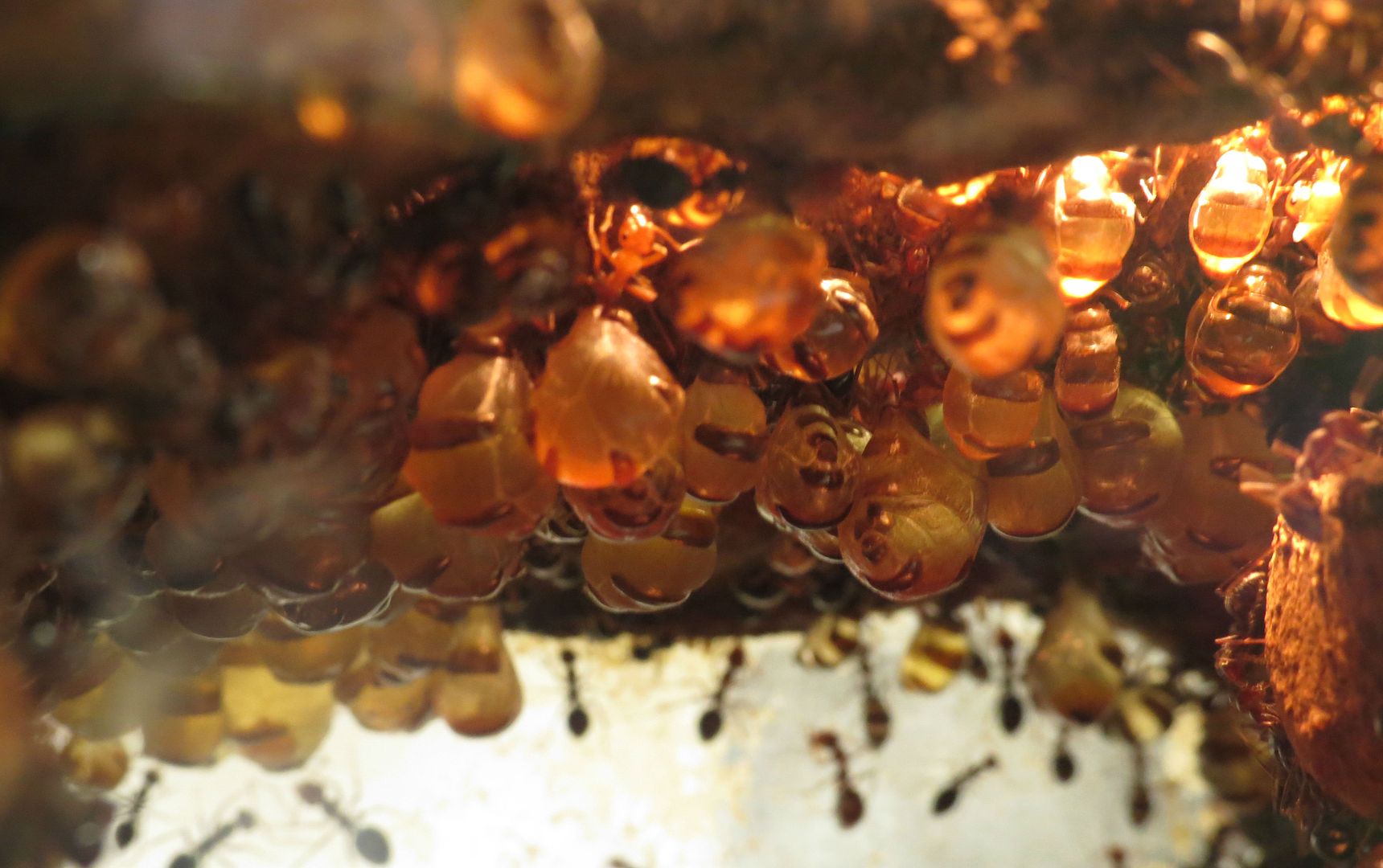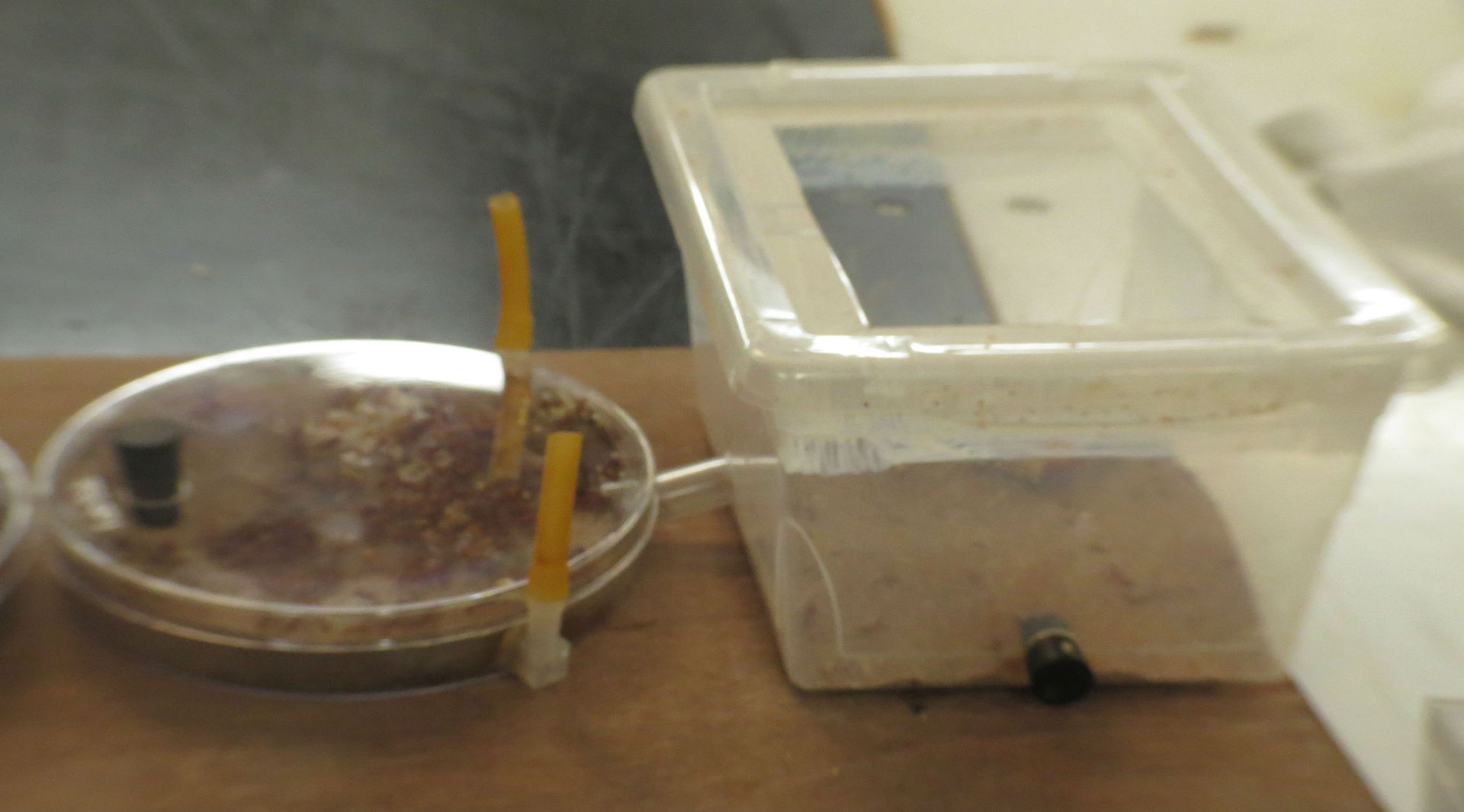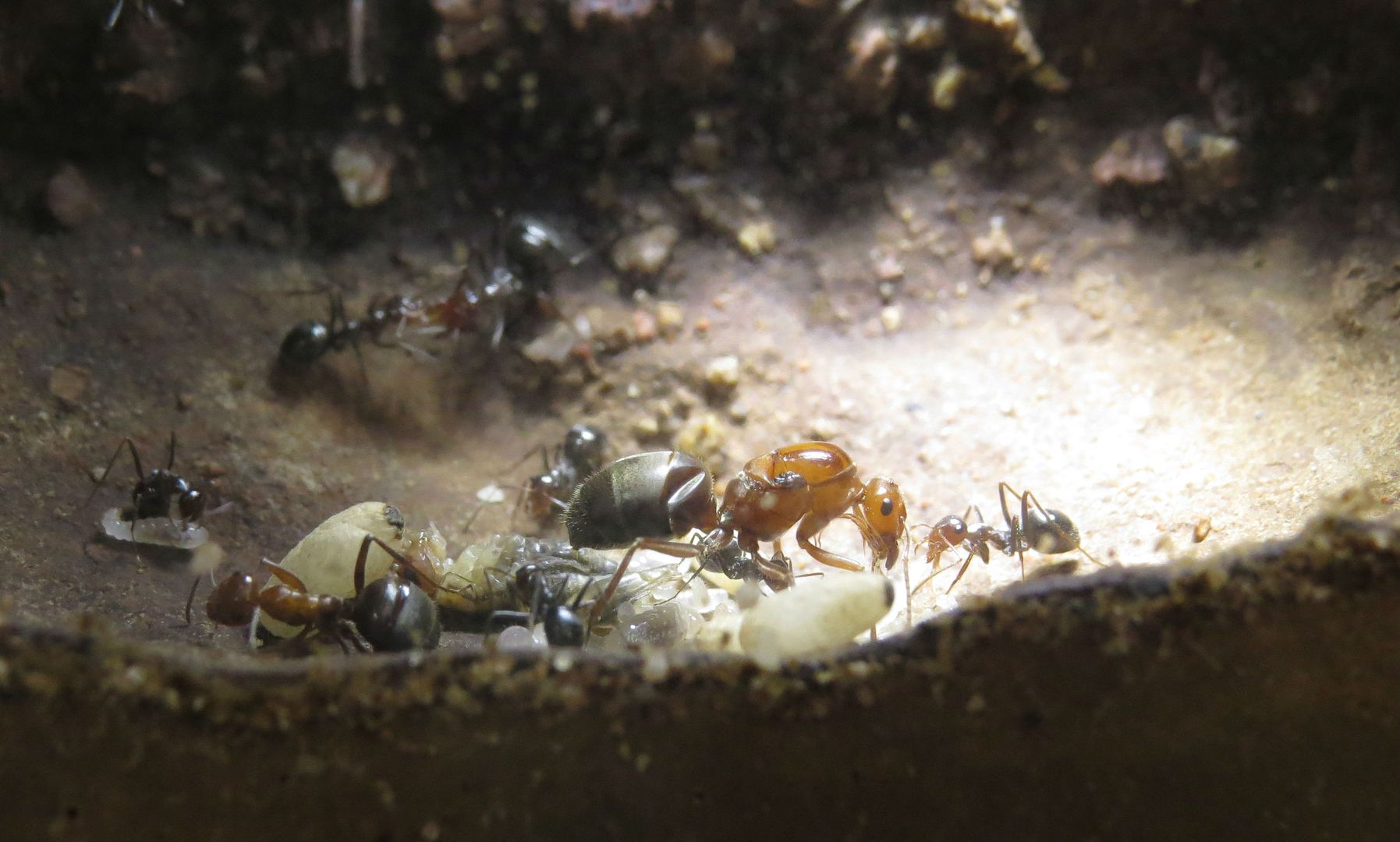Thursday, November 13, 2014
Bees on Georgia Aster
Georgia Aster, Symphyotrichum georgianum, is one of the last asters to bloom. Flowers open right when the leaves start to fall around October into November. Presumably the purple flowers are better contrasted with yellow leaves that accumulate in the foliage. Despite the common name of, Georgia Aster, this species is fairly cold hardy and can grow well into zone 5. Where it occurs in the wild it's locally threatened and uncommon, but several nurseries have started carrying the species and it can be bought by mail order.
For the most part this plant spreads by forming a clump, similar to Aromatic Aster, Symphyotrichum oblongifolium, with new stems coming more and more each year in an outward pattern. Plants can be divided every few years or can be started by seed. Cuttings are probably easy to root too so the fact that this uncommon species is sold in nurseries is more forgivable. It's unlikely that plants are being stolen from the wild.
This past year I planted two plugs of this plant and at least one grew well enough to flower. The other I've lost track of among other plants but I assume it's doing fair. I intend to buy more of these this year, hopefully from a different nursery to ensure genetic diversity. I noticed my New England Asters didn't start reproducing by seed until I planted more than one. It's likely members of this genus benefit from cross-pollination to spread by seeds. A tip I learned while touring New Moon Nursery is you might as well try getting a stem or two to root right while they're young. Plugs often have too much green growth to roots as it is; they'll likely flower at the wrong time of year anyhow and it's beneficial for small plants if these buds are removed. Smaller cuttings survive better than bigger ones because it's the roots that hydrate all the growth above.
Wednesday, October 29, 2014
The Third Annual New Jersey Ant Together (Video)
The video supplement to out anting trip back in July.
Coming Soon: Ants of the Southwest!
Monday, October 13, 2014
Rover Ant Nuptial Flight
Brachymyrmex (Rover Ants) is a genus of mostly tramp species that have spread across the globe by human commerce. Colonies are more than happy to move into potted plants and are then transported around, usually a short distance but sometimes all over the place. It's not uncommon to bring a few colonies indoors in the winter time on accident either and species can be found in greenhouses throughout the world.
Despite a lot of nonnatives species in the genus spread around the world, they're not invasive. Colonies remain small and don't seem to displace other ant species.
Flights happen in late afternoon along side Lasius claviger, but seem to favor muggy days with an over cast to them and a slight chill in the air. Around 70 degrees is ideal of course but this species seems to be cold hardy, like Prenolepis imparis. They tend to favor nesting spots in damp, sandy soil, and go unnoticed on account of their size. Any mound formed around the entrance is usually insignificant, and on par with what a Monomorium would make, lots of extremely tiny dirt partials, unlike what a Lasius or Dorymyrmex species would produce.
Wednesday, October 1, 2014
Scoliid Wasps on Goldenrod
While touring New Moon Nursery I couldn't help but notice the alarming amount of Scoliid Wasps on their Goldenrod. I believe this is the cultivar 'Fireworks' but these are only plugs so they're not really representative of the adult plants. But even in flats, you can see a lot of these plants still try to flower.
Scoliid Wasps are parasites of beetle larva, including the nonnative Japanese Beetle. The adult form though is a pollinator that's fond of generalist composites and mint. Goldenrod, Aster, Mints and a few others are all good at attracting them to your yard. And because the larval stage consumes beetle larva they're beneficial to lawn health too.
Scoliid Wasps are parasites of beetle larva, including the nonnative Japanese Beetle. The adult form though is a pollinator that's fond of generalist composites and mint. Goldenrod, Aster, Mints and a few others are all good at attracting them to your yard. And because the larval stage consumes beetle larva they're beneficial to lawn health too.
Tuesday, September 30, 2014
Saturday, September 27, 2014
A Tour of New Moon Nursery
Being a member of the New Jersey Native Plant Society came with an unexpected perk this year. They held a fund raiser where we got to tour New Moon Nursery. They're a wholesale nursery native plant nursery, family run, started back in 2003. They do dabble in a few nonnatives but only under contract.
Before then the property used to be a chicken farm, and you can sort of see it in some of the buildings. Also they keep a couple dozen chickens around.
This is their shipping department, which was I believe they said were originally chicken cages from floor to ceiling. Basically one day a week, they go out and collect the flats to plants customers have ordered. They then take empty trays and assemble the orders from these flats and load them up into trucks or set them aside for customers to arrive and pick up.
It's at this point in the tour that we were given our free reign to fill up a flat of our own with with up to 50 plants, including a few things they had listed as limited supply and not available! The only real restriction was they had to be plug sized. This was a gift for just a $100 donation to the NJ Native Plant Society made well in advance. The nursery has 5 heated greenhouses, 10 row cover house, and a few outside areas filled with several hundred species of plants. Basically everything was up for grabs!
The tour continued into the greenhouses where they showed us how they start up seedlings in trays. I found it neat to learn they then take small cuttings of the seedlings after they germinate and root them to double plant production. The end product still maintains genetic diversity and they're able to mass produce cultivars that way.
Seedlings were a small part of the overall products they had. Pretty much everywhere else had hundreds of trays of plugs that we were free to take. It was actually fun just walking around the greenhouses, letting your hands glide across warm season grasses, rushes, Amsonia, and other perennials.
Around back they had an area setup for shade plants. These were mostly sedges which are more cold and shade tolerant than most grasses. They are also larger than plug size and thus not up for grabs, though each species was represented in the greenhouses where we were free to take them.
There was a small garden area back here where one native plant stole the show.
Spigelia marilandica, Indian Pink, is a shade plant with a brilliant red and yellow flower. Despite the slight warning "It will spread on you," this perennial remains one of the more expensive and in high demand native plants around. This is something of a contradiction that I don't know the answer to. (Probably should have asked while I was there, whoops.) I think the demand is created by the fact that so few growers grow the plant.
Around the front was the Pièce de résistance. This is where most of their plants are kept that are ready for sale. At this point the tour basically fell apart as everyone went and started filling up their trays.
Naturally I'm drawn to what brings in the pollinators, and this time it was a surprising number of cultivars.
I had to just marvel at the number of Scoliid Wasps on their goldenrod they had. There must have been a thousand of them on this one patch.
Two Hours Later, here's what I brought home:
5 Helianthus angustifolius, my favorite Swamp Sunflower.
5 Spigelia marilandica, Indian Pink.
5 Senecio aureus, Golden Ragwort, which I'm trying out in the meadow garden.
5 Sedum ternatum, Stonecrop, which I'm giving a try for the first time.
5 Symphyotrichum laevis 'Bluebird', which I've seen in action among black eyed susans and they look great together.
5 Symphyotrichum oblongifolius 'October Skies' which I have blooming now in nice fluffy domes of flowers out in the meadow.
5 Symphyotrichum noave-angliae 'Purple Dome'. This New England Aster is a compact cultivar, similar to S. oblongifolius. I was going to alternate this with 'October Skies' to make a boarder.
5 Caltha palustris, Marsh Marigold, I've been trying to establish for years now and think I have a spot it might like to grow.
5 Sisyrinchium angustifolium, Blue-eyed Grass.
2 Eurybia spectabilis, Showy Aster, was a last second decision. The flowers are larger than most Asters and certainly are showy, but I recall the overall plant not being that impressive.
3 Chrysogonum virginianum 'Superstar'. This is a selection of Green and Gold which is another first for my yard. It's a shade loving ground cover that blooms from April into June.
All and all I'd say it was a great trip.
Also Photographed:
In the cardboard are plants from Bluestone Perennials.
3 Solidago 'Fireworks'
3 New England Aster 'September Ruby'
I bought these two because they flower together and I love the combination of red and yellow.
(Also not photographed are a few dozen Tulipa clusiana 'Lady Jane' bulbs which I'm giving a try next year. I'm curious to see if species tulips are better at attracting pollinators.)
And a native Pitcher Plant which had some Sundews flowering in the moss. This came as a free gift from Aquascapes Unlimited.
Before then the property used to be a chicken farm, and you can sort of see it in some of the buildings. Also they keep a couple dozen chickens around.
This is their shipping department, which was I believe they said were originally chicken cages from floor to ceiling. Basically one day a week, they go out and collect the flats to plants customers have ordered. They then take empty trays and assemble the orders from these flats and load them up into trucks or set them aside for customers to arrive and pick up.
It's at this point in the tour that we were given our free reign to fill up a flat of our own with with up to 50 plants, including a few things they had listed as limited supply and not available! The only real restriction was they had to be plug sized. This was a gift for just a $100 donation to the NJ Native Plant Society made well in advance. The nursery has 5 heated greenhouses, 10 row cover house, and a few outside areas filled with several hundred species of plants. Basically everything was up for grabs!
The tour continued into the greenhouses where they showed us how they start up seedlings in trays. I found it neat to learn they then take small cuttings of the seedlings after they germinate and root them to double plant production. The end product still maintains genetic diversity and they're able to mass produce cultivars that way.
Seedlings were a small part of the overall products they had. Pretty much everywhere else had hundreds of trays of plugs that we were free to take. It was actually fun just walking around the greenhouses, letting your hands glide across warm season grasses, rushes, Amsonia, and other perennials.
Around back they had an area setup for shade plants. These were mostly sedges which are more cold and shade tolerant than most grasses. They are also larger than plug size and thus not up for grabs, though each species was represented in the greenhouses where we were free to take them.
There was a small garden area back here where one native plant stole the show.
Spigelia marilandica, Indian Pink, is a shade plant with a brilliant red and yellow flower. Despite the slight warning "It will spread on you," this perennial remains one of the more expensive and in high demand native plants around. This is something of a contradiction that I don't know the answer to. (Probably should have asked while I was there, whoops.) I think the demand is created by the fact that so few growers grow the plant.
Around the front was the Pièce de résistance. This is where most of their plants are kept that are ready for sale. At this point the tour basically fell apart as everyone went and started filling up their trays.
Naturally I'm drawn to what brings in the pollinators, and this time it was a surprising number of cultivars.
I had to just marvel at the number of Scoliid Wasps on their goldenrod they had. There must have been a thousand of them on this one patch.
Two Hours Later, here's what I brought home:
5 Helianthus angustifolius, my favorite Swamp Sunflower.
5 Spigelia marilandica, Indian Pink.
5 Senecio aureus, Golden Ragwort, which I'm trying out in the meadow garden.
5 Sedum ternatum, Stonecrop, which I'm giving a try for the first time.
5 Symphyotrichum laevis 'Bluebird', which I've seen in action among black eyed susans and they look great together.
5 Symphyotrichum oblongifolius 'October Skies' which I have blooming now in nice fluffy domes of flowers out in the meadow.
5 Symphyotrichum noave-angliae 'Purple Dome'. This New England Aster is a compact cultivar, similar to S. oblongifolius. I was going to alternate this with 'October Skies' to make a boarder.
5 Caltha palustris, Marsh Marigold, I've been trying to establish for years now and think I have a spot it might like to grow.
5 Sisyrinchium angustifolium, Blue-eyed Grass.
2 Eurybia spectabilis, Showy Aster, was a last second decision. The flowers are larger than most Asters and certainly are showy, but I recall the overall plant not being that impressive.
3 Chrysogonum virginianum 'Superstar'. This is a selection of Green and Gold which is another first for my yard. It's a shade loving ground cover that blooms from April into June.
All and all I'd say it was a great trip.
Also Photographed:
In the cardboard are plants from Bluestone Perennials.
3 Solidago 'Fireworks'
3 New England Aster 'September Ruby'
I bought these two because they flower together and I love the combination of red and yellow.
(Also not photographed are a few dozen Tulipa clusiana 'Lady Jane' bulbs which I'm giving a try next year. I'm curious to see if species tulips are better at attracting pollinators.)
And a native Pitcher Plant which had some Sundews flowering in the moss. This came as a free gift from Aquascapes Unlimited.
Sunday, September 21, 2014
Black Swallowtail Caterpillars (2014)
This year's crop of Black Swallowtail Caterpillars is shaping up to be a nice one. I have at least 15 caterpillars all coming of age to form their chrysalises. The had ignored my yard all year until a month ago, despite having 8 full clumps of parsley and a patch of Golden Alexander going strong. And it all seems to be thanks to one female flying through the yard one day.
I'm going to leave these outside in a sheltered cage for the winter. Hopefully I'll have better luck than I did two years ago when I raised them in a cold basement room. They started emerging in February and in batches every two weeks after that. I doubt they'd like to fly when there's snow on the ground.
I have read that butterflies like Gatorade and will drink it in place of nectar or rotting fruit, however I was never able to get it to work. Captive butterflies just don't seem interested in feeding, though I'm sure I was doing something wrong.
I'm going to leave these outside in a sheltered cage for the winter. Hopefully I'll have better luck than I did two years ago when I raised them in a cold basement room. They started emerging in February and in batches every two weeks after that. I doubt they'd like to fly when there's snow on the ground.
I have read that butterflies like Gatorade and will drink it in place of nectar or rotting fruit, however I was never able to get it to work. Captive butterflies just don't seem interested in feeding, though I'm sure I was doing something wrong.
Wednesday, September 3, 2014
Arizona: Meeting Ray Mendez
An incredible highlight of the Ants of the Southwest course was a visit to Ray Mendez's house.
Here is his house, and that's the view he gets to wake up to every morning.
It's Pogonomyrmex adjacent.
Inside he has some interesting artwork hanging from the ceiling. But you might be asking, what makes Ray so special?
He made the alien egg and worked on some of the effects for the movie "Alien." He also helped inspired what has to be the greatest tagline for a horror movie in cinema history. "In space no one can hear you scream."
He did the bug work for the film, "Silence of the Lambs."
It's actually a cockroach done up to be a moth.
He was the roach wrangler to the film "Joe's Apartment," which is admittedly a bad movie but the stories he has to tell about making it sound like they had an awesome time filming. (They got to pump a few thousand roaches up a girl's dress.)
His portfolio includes a smattering of advertising campaigns.
Here Ray bestows his wisdom to the Ants of the Southwest class in his workshop.
He also builds professional grade setups for museum exhibits and sets used for documentations to film. Pictured above is an above ground scene used in "Empire of the Desert Ants" a few years ago. It's hard to see but there are two openings leading down beneath the setup. Two different colonies can be hooked up here and their interactions filmed. For the documentary they filmed both the demise of the main colony, as well as the main colony conquering anther nest all at the same time. Because the ants of both colonies look identical you don't know that you're looking at two separate colonies.
For these setups, whole nests can be attached underneath. This allows camera men to film the workers right as they emerge from the hole. The whole setup as well as the disk can also be buried in the ground and blended in with the surrounding soil. This way filmmakers can have an ant nest in an ideal location for both lighting, background, and ambiance.
Here are two nest setups placed side to side. Each one is its own chamber to help with a movie trick. Also note the openings in the hydrostone/plaster against the plexiglass along the top.
Though empty now, ants can be added as needed. Because the front setup has windows on both sides, you can look all the way through into the second setup. Should a scene call for a wall of honeypot ants hanging in the background, to show the colony is doing well, they just slide that setup in back. But should the scene call for the colony having to rough it, they can either remove the ants or change the background nest entirely. This is a trick I'd like to incorporate into future setup designs someday.
When filming honeypot ants it's always nice being able to make the honeypots glow. This is achieved by shining a flash light down through the openings in the hydrostone/plaster.
As seen here.
And here.
Condensation can be an issue at times. Ray uses a fan, on low, to blow through a tube, sending a light breeze through the nest. It's important to leave a gap between the fan and the tube, otherwise it will create a wind tunnel and can blow the ants right out of the setup or dry it out too quickly. Typically ants don't go through tunnels that have wind blowing through them, but the use of metal mesh might be required.
Watering is done by placing a tube through the bottom of the setup when casting.
Once it's dry the tube can be removed and the ends replaced by nozzles. This way water can be added beneath the ants nesting area and allowed to absorb into the rest of the setup.
Setups for his personal colonies are surprisingly simple and yet ingenious.
New queens are started in clusteral setups. Plaster lining the bottoms of vented containers. And a VERY THIN LAYER of soil media is added. I emphasis very little because Ray doesn't want the queen digging down into it, or building walls that will only collapse when watered. Also it was nice knowing that even he suffered from the problem "Collect 50 queens and maybe 10 of them are successful."
Queens that rear their first workers are moved into slightly larger setups. In this case a Myrmecocystus species, Honeypot ants.
Upon getting their first few repletes, he upgrades their nesting accommodation as needed.
We all got to eat a replete too. There's a trick to it because they're in a subfamily known for Formic Acid. You rupture them first to let the volatile chemicals disperse a sec, and then eat the mess left in your hand. Eating them whole also works but there's an immediate displeasing taste from the formic acid.
All his repletes had a taste of apples because he always keeps a slice of apple in the foraging area. The ants nibble at the apple over time, and then place their waste upon it, making clean up nice and easy. All you need to do is replace the apple slice.
Colonies of Pogonomyrmex, harvester ants, are notorious for stuffing crud and frass right up against the glass. To get around this, he places them in horizontal setups so the ants can be viewed from above.
He does this with Aphaenogaster too but but I'm not sure if there was any specific reason for it.
He has a colony of Atta, Leaf-cutter Ants!
Leaf-cutter Ants cut up leaves to bring home and feed to their fungus gardens.
Here you can see the media workers placing little bits of leaves among the fungi.
Near the top of the main garden lies the queen. Atta queens are the largest ants in the United States at ~25mm long. The next closest comparison are some of our Carpenter ant queens that can be as large as ~20mm long.
The only real tip he had about keeping fungus ants was to never let them grow their fungus on the ground. New queens just starting out sort of have to make do, but established colonies, even ones with basketball sized fungus gardens don't let their fungus sit on the ground. Often the fungus will grow amongst the roots of plants or on top of stones.
I learned an awful lot from Ray and can't wait to put this knowledge to good use. I'm thrilled to have met him and even asked for his autograph.
Friday, August 29, 2014
Arizona: Dorymyrmex Study
Dorymyrmex, despite being a common genus, remains something of a mystery in North America. The trouble is that no one's really studied them well enough to get the genus right. Eastern species are fairly well known, but out west.... the genus is in pure chaos. Basically if it's black it keys out to Dorymyrmex insanus, and studies that look into the matter simply describe new species with a sentence or two.
The station we stayed at had loads of colonies of them on the property. We spent a day flagging each of them, and then putting sets of workers together to see if they got along or not.
Workers from the same colony got along, those from different one almost murdered on another on sight.
Though time consuming, it's fun work.
We found that the colonies had changed boundaries from the previous year, as well one of them had become massive in size (not in photo). Pictured above is a typical nest comprised of maybe 6 to 12 holes. The large colony crossed one of the trails here and was comprised of 26 holes.
We dug up one nest and found the general structure of one of their nests is simply one narrow tunnel leading down at a slight angle, leading through several galleries.
For time reasons we didn't get down below 3'. And it likely extends much deeper than that. Most of the ant nests in the area seem to go down 12' or so. How many queens they have, or if the ant hills are connected somehow underground are unknown. It's likely that these nests are not connected and there might be only one queen per hole, but also likely that in the winter the nests combine down into fewer holes. Perhaps queen number and or age help determine the number of satellite holes.
That was the extent of our study. Future courses may continue the work.
The station we stayed at had loads of colonies of them on the property. We spent a day flagging each of them, and then putting sets of workers together to see if they got along or not.
Workers from the same colony got along, those from different one almost murdered on another on sight.
Though time consuming, it's fun work.
We found that the colonies had changed boundaries from the previous year, as well one of them had become massive in size (not in photo). Pictured above is a typical nest comprised of maybe 6 to 12 holes. The large colony crossed one of the trails here and was comprised of 26 holes.
We dug up one nest and found the general structure of one of their nests is simply one narrow tunnel leading down at a slight angle, leading through several galleries.
For time reasons we didn't get down below 3'. And it likely extends much deeper than that. Most of the ant nests in the area seem to go down 12' or so. How many queens they have, or if the ant hills are connected somehow underground are unknown. It's likely that these nests are not connected and there might be only one queen per hole, but also likely that in the winter the nests combine down into fewer holes. Perhaps queen number and or age help determine the number of satellite holes.
That was the extent of our study. Future courses may continue the work.
Subscribe to:
Posts (Atom)

